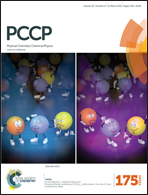The effects of framework dynamics on the behavior of water adsorbed in the [Zn(l-L)(Cl)] and Co-MOF-74 metal–organic frameworks†
Abstract
The effects of framework flexibility on the structural and dynamical properties of water adsorbed in two prototypical metal–organic frameworks are investigated through molecular dynamics simulations. It is found that water molecules in the pores of a flexible model of [Zn(l-L)(Cl)] exhibit slower dynamics than when the framework is artificially held rigid in the simulations. In contrast, the water dynamics in Co-MOF-74 is predicted to be accelerated by the framework vibrations. The origin of this different behavior directly relates to how water interacts with the two frameworks, which, in turn, determines different hydrogen-bond patterns in the pores. While the first water molecules adsorbed in [Zn(l-L)(Cl)] donate a single hydrogen bond to the Zn–Cl groups and point the other hydrogen atom towards the center of the pore, water molecules adsorbed in Co-MOF-74 initially bind to the cobalt atoms of the framework via their oxygen atoms, thus leaving each molecule free to form two hydrogen bonds with additional molecules adsorbed at higher loading. The simulation results indicate that taking into account the framework flexibility in computer simulations is necessary for a quantitative modeling of adsorption and transport processes in metal–organic frameworks.
![Graphical abstract: The effects of framework dynamics on the behavior of water adsorbed in the [Zn(l-L)(Cl)] and Co-MOF-74 metal–organic frameworks](/en/Image/Get?imageInfo.ImageType=GA&imageInfo.ImageIdentifier.ManuscriptID=C5CP07681A&imageInfo.ImageIdentifier.Year=2016)

 Please wait while we load your content...
Please wait while we load your content...